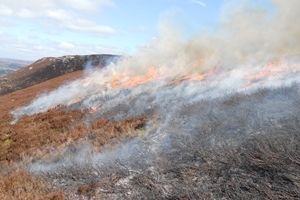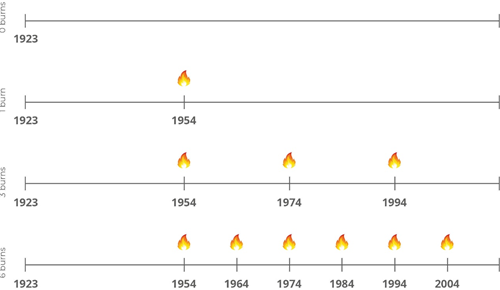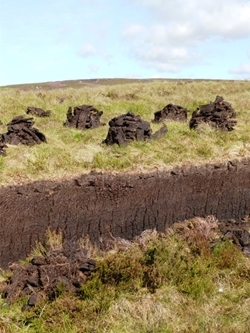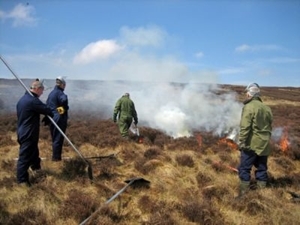Although this paper is not published by GWCT scientists and does not represent the views of the GWCT, this summary has been produced for our members, and the wider public, to increase the accessibility of the scientific literature. It is important to remember that each individual paper should not be thought of alone, but considered in the context of the wider evidence available in that area.
Key findings
- Peat moorlands are important for carbon storage and they support rare wildlife communities.
- Heather burning is a traditional tool used for managing many heather moorlands.
- There is lots of debate about the effect of heather burning and whether it is damaging to peat, carbon storage, or biodiversity.
- This study looked at the effect of burning at different length rotations on peat formation, carbon storage and plant diversity.
- Peat growth and carbon storage occurred in all groups, with each burn reducing the amount stored each year by around 4%.
- Peat formation and carbon storage was significantly lower on sites that had been burnt six times over the study period, but no other groups were significantly affected.
- Biodiversity was highest on the areas burnt six times over the study, and lowest on those burnt once.
- Heather cover was highest on the areas burned least and lowest on those burnt six times.
- Sphagnum moss and cotton grass cover was highest on areas burnt six times.
- For this moorland site, a programme of burning once every 20 years was recommended to maintain peat growth and carbon storage, whilst maximising biodiversity and reducing wildfire risk.
Background
 Heather moorlands are very important areas for both carbon storage and biodiversity. They often sit on peat soils, which store around 30% of the world’s soil carbon. Rotational heather burning is a traditional tool used for managing many moorlands, after which the heather regenerates, and this prevents it becoming old and woody. However, in the UK the use of fire as a management tool is increasingly considered controversial, with concerns around its effect on carbon storage, water quality, flood risk and biodiversity. Where burning is not used, heather can build up and other vegetation develops which is more prone to wildfires. Wildfires can be much more damaging than prescribed fires, so the moorland manager is in a difficult position when deciding whether to use prescribed burning to best protect their land. This paper helps fill some of the gaps in the scientific evidence around burning.
Heather moorlands are very important areas for both carbon storage and biodiversity. They often sit on peat soils, which store around 30% of the world’s soil carbon. Rotational heather burning is a traditional tool used for managing many moorlands, after which the heather regenerates, and this prevents it becoming old and woody. However, in the UK the use of fire as a management tool is increasingly considered controversial, with concerns around its effect on carbon storage, water quality, flood risk and biodiversity. Where burning is not used, heather can build up and other vegetation develops which is more prone to wildfires. Wildfires can be much more damaging than prescribed fires, so the moorland manager is in a difficult position when deciding whether to use prescribed burning to best protect their land. This paper helps fill some of the gaps in the scientific evidence around burning.
The study takes advantage of the fact that peat is a substance that grows upwards as it forms. New layers of vegetation are deposited on the top, and because of the conditions these plant materials do not rot in the normal way but add to the peat over a long period of time. This process of formation allows scientists to cut samples down through the peat (‘cores’) and measure the layers they find, which can act as a historical record. For example, measuring radio-isotopes deposited in the peat can identify known points, and this allows the scientists to measure the recent peat accumulation rates.
What they did
At Moor House National Nature Reserve, a long-term experiment to study the effect of different burning management has been running since 1954. All areas were burnt in 1954, and since then some areas were left unburned, and other areas have been burnt more regularly on rotation; either every ten or 20 years. There were also designated areas outside the experiment that had not been burned since around 1923.

Figure 1: Different burn management approaches on the sites in this study.
In this study, the scientists looked at how much peat has formed in the different areas managed in different ways. They took ‘peat profiles’ – a core sample down through the peat to a depth of 50cm – in 32 different plots that had been burned in the different ways.
The lead concentrations were measured down through these cores and compared with those in which radio-isotopes were measured. Standardising the cores against each other in this way allowed the scientists to calculate peat growth, and the amount of carbon that has been stored in the peat.
The results measured the effects of the different burning managements on the rates of peat formation and carbon storage.
As well as taking peat samples from the different burn management areas, the scientists also measured the plant communities found there, particularly heather, sphagnum mosses and cotton grass coverage. These were also compared between burn management sites, to see how burning had affected plant biodiversity.
What they found
 There was a significant difference in peat formation and carbon storage between the group that was burnt six times and the unburnt areas. There was no difference between any of the other groups. Less peat was formed, and less carbon stored per year on the areas burnt six times compared to those not burnt at all. This difference was only seen in the mass of peat and carbon, but not in the depth of peat laid down, so it must be that the peat formed was denser where it was not burnt compared to when it was burnt more often.
There was a significant difference in peat formation and carbon storage between the group that was burnt six times and the unburnt areas. There was no difference between any of the other groups. Less peat was formed, and less carbon stored per year on the areas burnt six times compared to those not burnt at all. This difference was only seen in the mass of peat and carbon, but not in the depth of peat laid down, so it must be that the peat formed was denser where it was not burnt compared to when it was burnt more often.
Although the difference in burning regimes was only significant between the no-burn and six-burn groups, there were small differences through all the groups indicating that each additional burn caused a small extra loss in peat and carbon storage. The scientists found that for each additional burn in the time period studied, peat and carbon accumulation was around 4% lower (4.9 grams less per metre per year for peat, and 1.9 grams less per metre per year for carbon).
When looking at biodiversity, the scientists found that heather cover was greatest on the areas burnt not at all or only once, and lower on those burnt three or six times. Sphagnum moss and cotton grass were both highest where six burns were carried out, and they used an index of biodiversity that showed that areas with six burns had the highest biodiversity, followed by those burnt three times, and the least biodiversity was seen in the areas only burnt once.
What does this mean?
 This paper adds greatly to the ongoing discussion about heather burning on moorland. It shows that carbon storage and peat formation did not stop where heather burning was used, but that they both decrease by around 4% per year with each extra burn. It also challenges the view that prescribed burning produces a moorland covered only in heather, at the expense of other species. These results show that, over a study covering 90 years, areas burnt only once had more heather and less of other species compared to areas burnt three or six times. This is particularly important at the moment as we experience climate change, because unburnt moorland with large quantities of old, woody or dead heather are thought to be at higher risk of wildfire. Wildfire on moorland that spreads to the underlying peat can be devastating and extremely difficult to control, leading to loss of stored carbon, surface vegetation and subsequent peat erosion.
This paper adds greatly to the ongoing discussion about heather burning on moorland. It shows that carbon storage and peat formation did not stop where heather burning was used, but that they both decrease by around 4% per year with each extra burn. It also challenges the view that prescribed burning produces a moorland covered only in heather, at the expense of other species. These results show that, over a study covering 90 years, areas burnt only once had more heather and less of other species compared to areas burnt three or six times. This is particularly important at the moment as we experience climate change, because unburnt moorland with large quantities of old, woody or dead heather are thought to be at higher risk of wildfire. Wildfire on moorland that spreads to the underlying peat can be devastating and extremely difficult to control, leading to loss of stored carbon, surface vegetation and subsequent peat erosion.
The authors of this paper suggest that on this moorland, burning approximately every 20 years would reach a balance that retains the benefits of carbon storage and peat growth, alongside increased biodiversity and reduced fire risk. This would need to be adjusted for different areas, depending on many factors such as how fast the vegetation grows. The main conclusion of this paper is that prescribed burning on peatlands is not necessarily damaging – it can increase biodiversity and reduce fire risk, with only a small cost for peat formation and carbon storage.
Read the original abstract
Marrs, R. H., Marsland, E. L., Lingard, R., Appleby, P. G., Piliposyan, G. T., Rose, R. J., O’Reilly, J., Milligan, G., Allen, K. A., Alday, J. G., Santana, V., Lee, H., Halsall, K. & Chiverrell, R. C. (2018) Experimental evidence for sustained carbon sequestration in fire-managed, peat moorlands. Nature Geoscience.